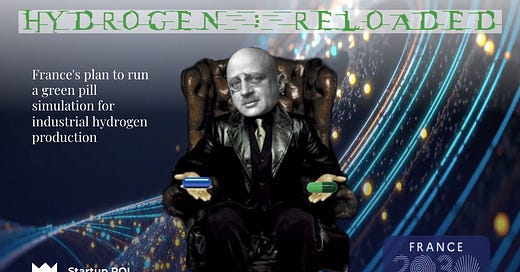✳️ Hydrogen : Reloaded
France's plan to run a green pill simulation for industrial hydrogen production
Welcome to Startup ROI, where we explore global technology trends and how they manifest themselves in France 🇫🇷 . Whether you're an entrepreneur, investor or tech enthusiast, I'm glad to have you here! 📩 Get in touch
📌 If you are a startup interested in being featured or a VC interested in collaborating, please reach out directly: bonjour@startup-roi.com
🎧 Listen to the audio version:
New here? Subscribe to get Startup ROI each Tuesday:
Introduction: France 2030 (2me Parti)
A couple of weeks ago, I introduced an on-going series covering Macron's vision for France 2030 as well as the startups and industry players that will directly contribute to achieving those goals. In case you forgot, here is a summary of his 10 Objectives. The first installment covered France's history with Nuclear Energy and the prospect of it playing a key role in the transformation towards sustainable energy practices. Today, we move on to another critical, but certainly less visible subject: green hydrogen.
As I'm writing this, leaders from around the world are discussing the future of energy policy at the UN Climate Change Conference in the UK (COP26). One of the many objectives of the conference is to secure net-zero carbon emissions by mid-century by accelerating the phase-out of coal, curtailing deforestation, speeding the transition to electric vehicles and encouraging investment in renewables. Conspicuously, green hydrogen isn't mentioned. Hopefully by the end of this essay, you'll see why that may be a strategic oversight. One that France plans to avoid.

The Questions We Will Ask Today:
What exactly is green hydrogen?
How do we produce hydrogen and what is it used for?
What are some practical applications for hydrogen-based power and why aren't they more widely adopted?
How do we overcome some of the logistical complexities to produce and use green hydrogen domestically?
Can hydrogen play a part in decarbonizing industry? What about general transportation? Or aviation?
What are the implications of transitioning towards green hydrogen on the environment, economy and international relations?
Flying Cars and Hydrogen Fuel Cells
Remember in Back to the Future, when Doc Brown lands in suburbia with his compost-powered, flying car? I remember seeing that and thinking how cool it would be if we really could capture and utilize the energy of everyday, abundant materials. Flying cars may still be on the technological horizon (c'mon antigravity research!) but we do, in fact, have the technology to turn something we have a lot of into clean and efficient fuel.

It's called a hydrogen fuel cell and it's been around for quite some time. The chemical reaction might appear to a layperson like something out of a sci-fi movie since we are so accustomed to combustion engines, burning gasoline or diesel, emitting noxious gases and particulate matter into the atmosphere. But reality can be stranger than fiction.

With the above configuration, it's possible power your vehicle with hydrogen and oxygen and the only exhaust coming out is water vapor. You could connect a tube to your tailpipe and stay hydrated on the road! You might be asking yourself: if this technology exists, why the hell aren't we using it? Well, we are. Most notably, for propulsion in spacecraft, but also for mass public transport, backup power generation among other utilities. It hasn't become as commercially available as, say, electric vehicles and even if it were, there's some behind the scenes carbon accounting that may have you thinking twice about the environmental impact of hydrogen fuel.
So what exactly is the hype about hydrogen? Is it actually green? And what are the roadblocks preventing us from implementing widespread usage?
Hydrogen is #1
Quite literally, hydrogen is the very first element on the periodic table. Hydrogen has 1 proton and 1 electron and therefore a mass & atomic number of 1. It is the most abundant element in the universe. You find it in our stars, oceans and atmosphere. So it makes a pretty good candidate for the perfect fuel source. If you can harness it, that is. Atomic hydrogen turns out to be very unstable, which makes it incredibly reactive, which is why it tends to pair with a twin to form hydrogen gas or H2 (of the famous H20 combo). Let's put aside the organic chemistry for now and get into why hydrogen production and use as a fuel source is making a comeback in the green energy debate.
I use the term "comeback" because producing and using hydrogen has been around for a long time. Most commonly, hydrogen is used in refining oil and fertilizer production, two industries that have their own responsibility to bear as it pertains to pollution. But the production of hydrogen itself is energy intensive and reliant on electricity. That is to say, despite its abundance, it's not so easy to capture, store and transport hydrogen. In France, the two aforementioned industries use around 900K tons of hydrogen each year, of which its production creates 9 million tons of carbon dioxide released into the atmosphere. To greenify this process, it will require a transition away from fossil-fuel generated electricity that powers electrolysis, the process resulting in hydrogen output. To benchmark progress, a spectrum has been developed to identify the level of sustainability associated with hydrogen production. And just like the periodic table in your middle school chemistry class, it's color-coded.

Historically, hydrogen production has been primarily "black" and "grey" — using fossil fuel as the energy source for production. Today, the debate tends to sit between "blue" and "green" hydrogen production. Blue hydrogen, in essence, is just grey hydrogen paired with carbon capture. Some argue, this offset justifies the usage of fossil fuels, especially in regions ill-equipped to implement renewable energy infrastructure; others, however, view it as a clever marketing exercise by the fossil-fuel industry in which they continue to supply energy to hydrogen producers and greenwash the product with some clever carbon accounting that isn't really accounted for… The alternative — and the leading choice in France — is green hydrogen, in which the electricity used to synthesize H2 is coming from purely renewable sources (wind, solar, hydraulic etc.).
In principle, this sounds relatively easy. The problem is that there isn't enough renewable energy at the moment to supply the requisite electricity to meet hydrogen demand. Hence, Macron's strategic investment to ensure environmental protection, stimulate the economy through the sector's development, and maintain energy and technological independence. These broad strokes can be distilled into three primary goals:
Install enough electrolysers to make a significant contribution to the decarbonization of the economy
Develop clean mobility, in particular for heavy transport
Build a French industrial sector that creates jobs and guarantees technological prowess (expectation of 50K - 150K jobs created directly or indirectly as a result)

The Hydrogen Economy
As per usual, we'll have to take a trip down memory lane to understand our current predicament. For this, I bring you a "wall of old white guys" that contributed to various iterations on our usage of hydrogen for practical purposes.
The fuel cell concept was dreamed up by Sir William Robert Grove way back in 1838. Nearly a century later, Sir Francis Thomas Bacon was able to create a practical hydrogen fuel cell, like the one we talked about earlier. But in between, German chemists Fritz Haber and Carl Bosch invented and commercialized, respectively, a process now known as "The Haber-Bosch" process for producing ammonia (NH3 i.e. nitrogen plus 3 hydrogen) which is commonly used as a fertilizer and in some cleaning products (oh yeah, and explosives). Long story short, the demand for hydrogen gas increased substantially and concern for the environment in the early 20th century wasn't exactly top of mind. In addition, lack of maturity and infrastructure made it difficult and expensive for a genuine hydrogen fuel cell to develop commercial viability. Nevertheless, the hydrogen economy was born. Unfortunately, its parent was the fossil fuel industry.
As technology develops and industry forms around it, we tend to get entrenched in a certain way of doing things. Complexity in supply chains, transportation and logistics, production methods and global economics have a way of imposing a sort of inertia within an industry, making it incredibly resistant to change. For example, at this stage, it would be impractical to attempt a global deployment of hydrogen fuel cell personal vehicles to the masses. Even if we had the technology and scale to make it happen, how would people fill up their tank? Who would store and transport the hydrogen fuel around the country? Would gas stations be open to investing in the transition? There are a lot of moving parts here, which is why the transition has to be gradual, intentional and industry (as opposed to consumer) first.
For example, the steel and cement industries both require hydrogen as an input in their production process. Not only is the production process itself a polluter, but the input, hydrogen, in most cases is itself derived from an emissions producing process (black/grey hydrogen).

By decarbonizing hydrogen production, we are decarbonizing industrial processes; simultaneously, as the production and infrastructure associated with green hydrogen scales, costs will decrease, driving further innovation and large-scale infrastructure plays that could lead, one day, to a fueling station for your hydrogen fuel cell vehicle of the future!
In a recent study on the hydrogen economy in Europe, France is poised to have the 2nd highest demand for hydrogen by 2030, just behind Germany. Which means they have a choice between importing it (at the risk of losing energy sovereignty and at the expense of their environmental goals) or producing it (retaining energy independence and giving them the upper hand in a world trying to make sense of the upcoming energy transition).
A Decades Long Head-Start
In his pitch on green hydrogen, Macron made two things clear. The first is that he won't repeat past mistakes on renewable energy (under-investment). The second is that France has a "trump card" he plans to exploit i.e. existing infrastructure, research and implementation of green energy practices, namely nuclear energy.


The play here, as is usually the case with massive infrastructure projects, is to build a public/private partnership that accelerates national priorities and turns a profit. On the private side you have legacy industry and innovative startups bringing new ideas to the scene with intent to reverse decades worth of inertia in the hydrogen economy. If you thought you were going to get through an article without mention of a few hydrogen-based #FrenchTech companies, you thought wrong!
Perhaps most notable is Lhyfe. Within the intricate network of the hydrogen economy, they are what you might call closest to the source. Ironically, their branding looks as though they are promoting premium bottled water. I guess they're only one oxygen atom away, so I can't blame them. In short, they provide a "building block" solution for regional governments or industry players to implement clean hydrogen production with the aim of eliminating emissions from the entire value chain. They recently raised a €50M round of funding to accelerate growth and development. Coincidentally, as I was preparing to launch Startup ROI, I did a series of Twitter threads on #FTGreen20 in which Lhyfe was prominently featured.

Hydrogenation Station
As tends to be the case, there is only so much I can pack into this little newsletter of mine. The hydrogen economy's resurgence and greenification presents great opportunities in our fight against climate change. There appears to be a confluence of collective willpower, technological maturity and public/private interest in transforming our energy supply. Green hydrogen is as good as any place to start.
The top-down plan of attack seems to be appropriate and happens to align quite well with other objectives in the France 2030 plan. By creating a market for green hydrogen we can decarbonize industry and apply the new know-how, infrastructure and pricing model to develop further down the value chain. Green hydrogen has the potential to transform aviation (an upcoming essay!), home heating, and off-grid electrification. Macron is promising two gigafactories to be in production on French soil within the decade. If you're unfamiliar with the term, perhaps Elon Musk & Leo DiCaprio can enlighten you. There are still major innovations across the supply chain that need to be accelerated but within the next decade, and even more so by mid-century, we should have a fairly comprehensive ecosystem for green hydrogen.
I'm neither a chemist nor a mechanical engineer. But I did watch a lot of YouTube videos (and read a few white papers) prior to publishing this. If today's essay encourages you to learn more (or made absolutely no sense and you need additional clarity) check the links below for further reading:
Resources:
Wood McKenzie Report
IEA Future of Hydrogen Report
Data Browser FRANCE IEA
Aurora Energy Research — Report
The Economist — Is Hydrogen the Energy of the Future?
Hydrogen Fuel Cell Beyond Cars — Undecided w/ Matt Ferrel
Future of Aviation with Hydrogen — Just Have a Think
Hydrogen Powered Aviation — McKinsey Report
Decarbonised Hydrogen France — Gov't Whitepaper
Ammonia as Jet Fuel — Popular Mechanics
Ammonia The Other Hydrogen — Euractiv












